Zipwake Dynamic Trim Control System
An Alternative to Traditional Trim Tabs
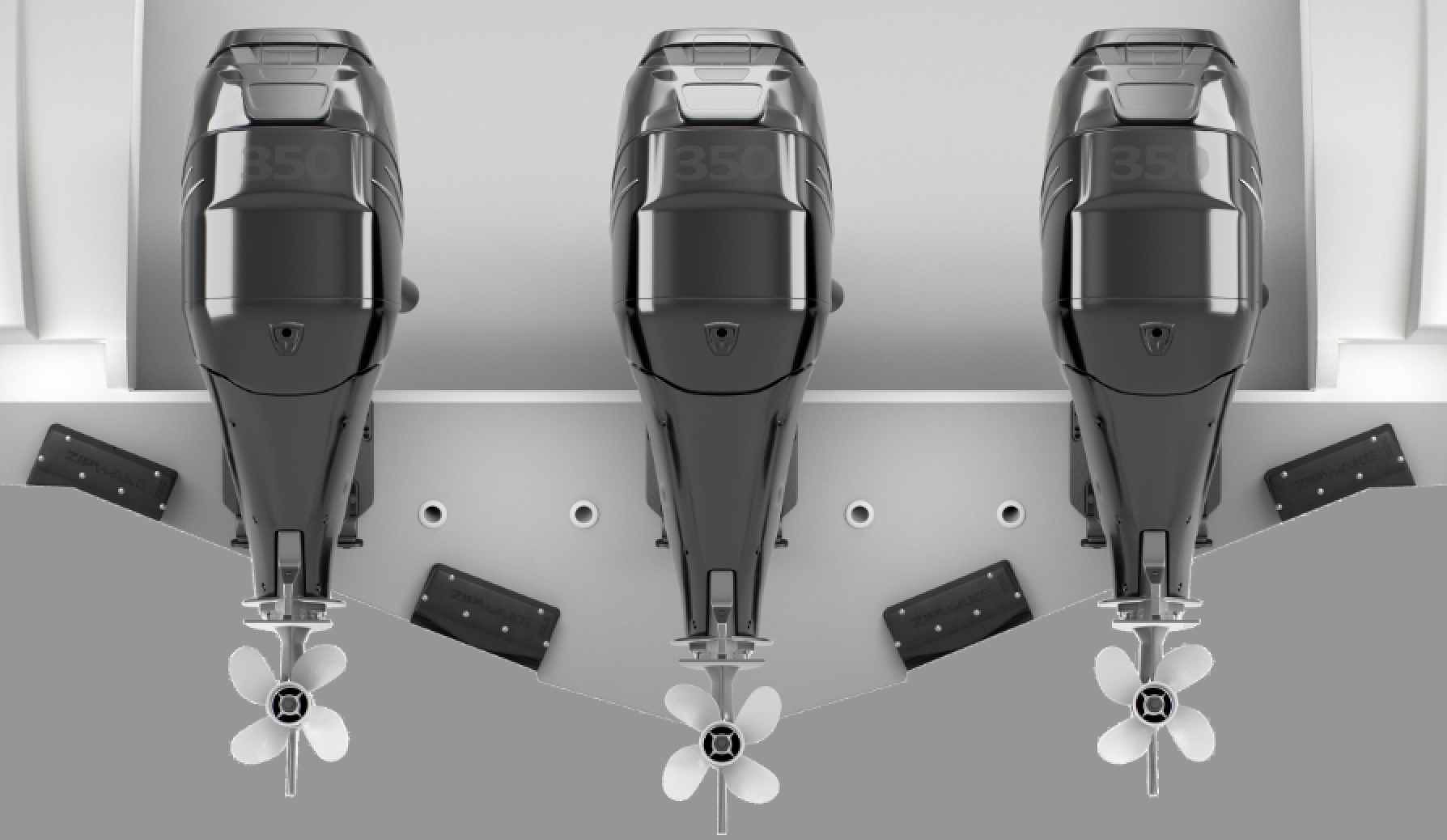
Zipwake is a maker of interceptors that are used instead of traditional trim tabs to adjust a boat’s running attitude. The Zipwake Dynamic Trim Control System adjusts trim and reduces pitch and roll for boats ranging from 20’ to 100’ (6.1 m to 30.48 m). It’s fully automatic and can enhance performance, fuel economy, comfort and safety for a boat and its passengers.
Experienced powerboaters are most likely familiar with trim tabs, which are plate-like devices bolted to a boat’s transom. With the exception of fixed models, they are hinged and extend aft from the transom. Most are electrically or hydraulically operated and are used to lift the transom and push down the bow to help a boat plane and ride more comfortably.
In the last 10 or so years, manufacturers like Zipwake have introduced interceptors. Sometimes referred to as “fences,” interceptors are blade-like devices that install on a boat’s transom. Instead of being hinged and using surface area to lift the boat’s stern, an interceptor drops straight down into the water, creating lifting pressure beneath the boat.
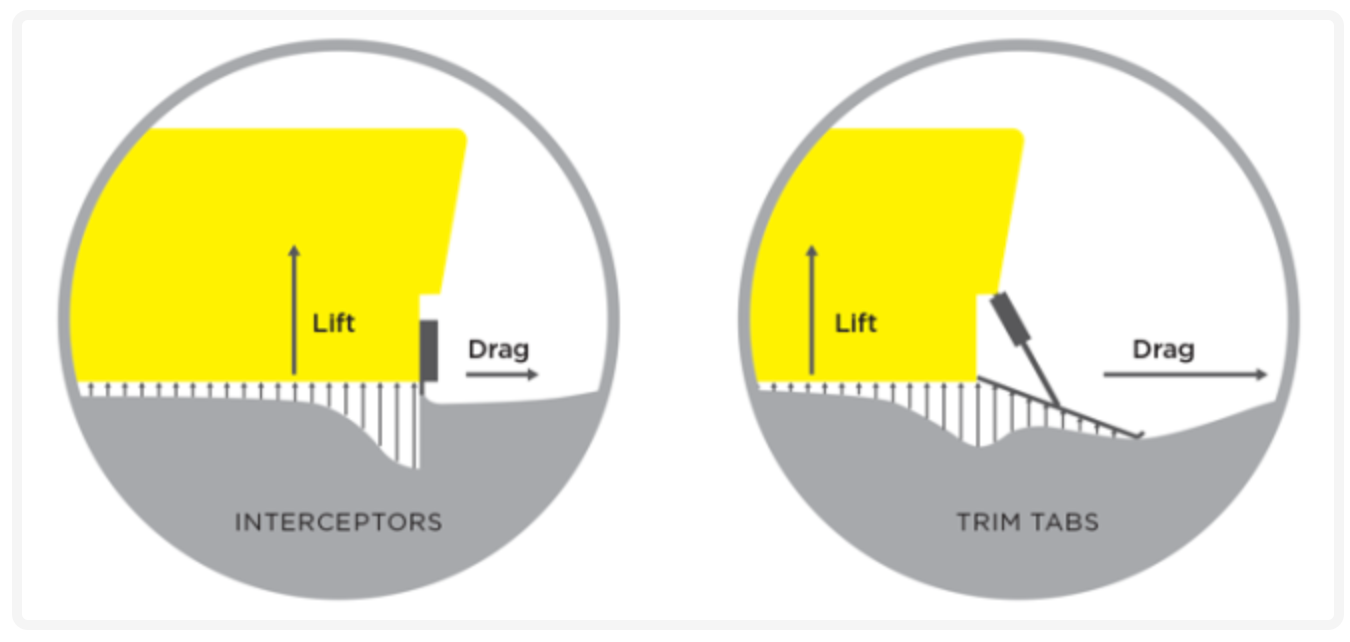
Common Elements
Boat trim is the fore-and-aft attitude of the hull of a boat at a given speed. A primary purpose of tabs and interceptors is to modify the trim or water flow past the boat so the hull takes the best attitude for speed and ride. The goal of manufacturers of interceptors and trim tabs is to lift the transom and lower the bow while underway, which should make the boat faster, smoother and more fuel-efficient.

Pros and Cons of Surface Area
Trim tabs are installed flush on a transom or within a dedicated pocket, most often in pairs. When tabs are lowered, they lift the stern and force down the bow on the side opposite of the tab’s position on the transom by pressing down into the water flowing past the transom. The farther the tab is lowered, the greater the effect the tab has.
Interceptors are mounted on the lowest surface of the transom. Like trim tabs, they redirect water flow to change the boat’s attitude. The biggest difference is that interceptors enter the water flow at approximately a right angle because they drop straight down abaft the transom. They extend a small distance of about 1” (25.4 mm) in the case of Zipwake products. For example, a Zipwake interceptor that is one foot (304.8 cm) wide has a blade that measures 12” x 1” (304.8 mm x 15.4 mm). Conversely, a trim tab measures 12” x 9” (304.8 mm x 228.6 mm) or 12” x 12” (304.8 mm x 304.8 mm).
Because of that extra size, a trim tab, theoretically, can foul lines in the water or be damaged by banging into docks or pilings. With interceptors, this is less likely.
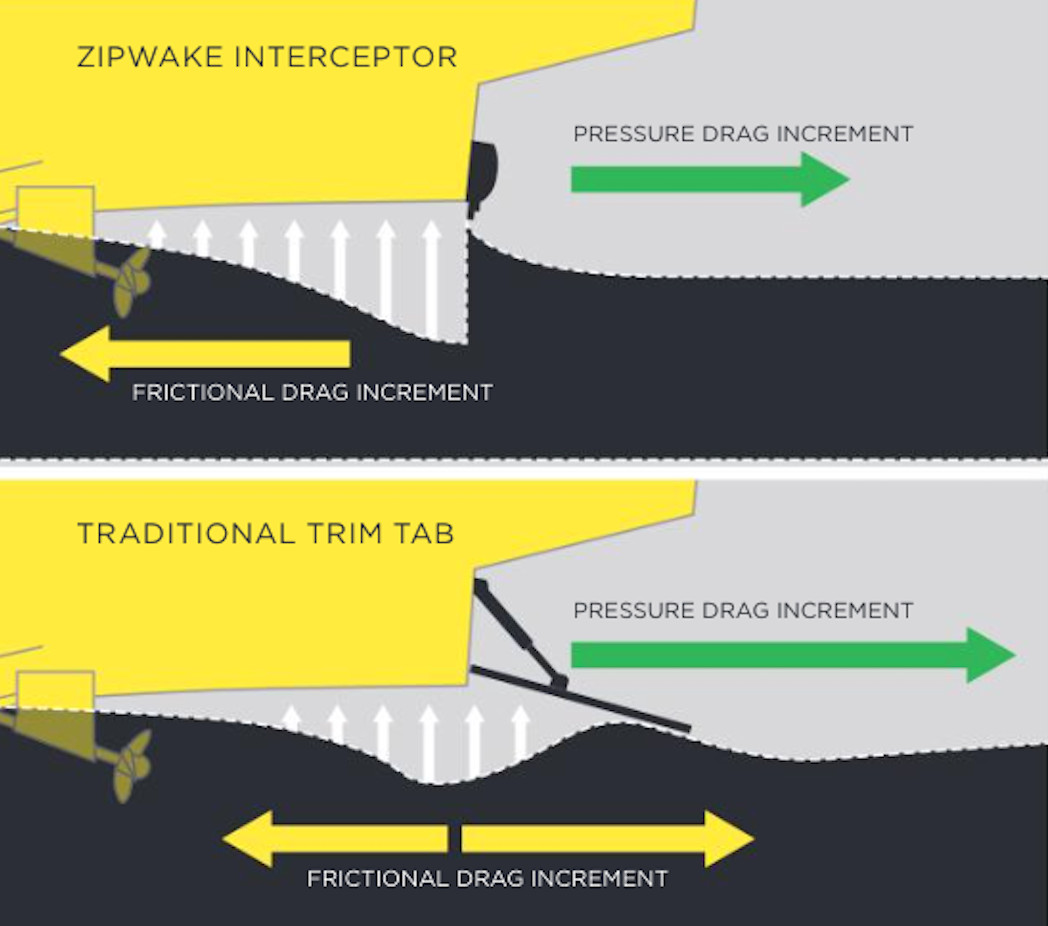
Efficiency
One of the main advantages that an interceptor system will have is the smaller blades and the speeds at which they deploy. Zipwake says its interceptors move from fully retracted to fully extended in 1.5 seconds. The company claims this is four to times faster than hydraulic trim tabs. Interceptors could help a boat plane more quickly.
The quicker reaction time also comes into play with Zipwake’s automatic Dynamic Trim Control System. If a boat is planing but listing to one side, Zipwake’s system has a gyroscopic sensor in the control head that balances the boat automatically by extending or retracting the port or starboard interceptor as needed. Automatic trim systems with tabs are designed to do the same thing.
Because the interceptors react more quickly than trim tabs, a smaller amount of the blade is needed to generate the stern lift needed to level the boat. Zipwake says automatic systems with tabs can respond to a longer, slower roll, but they “simply can’t keep up in a shorter, steeper chop.”
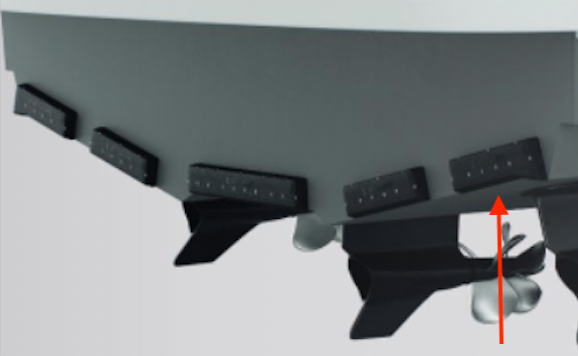
Among new products being offered by Zipwake are Chine Interceptors that are designed to match the chine angle and use the farthest outboard surface of the hull bottom for maximum lift generation. The S Series also has Intermediate Interceptors, smaller blades that can be installed in between outboard engines or sterndrives to help add lift. The E Series is designed for larger boats and includes Tunnel Interceptors that are curved to match the curve of a propeller tunnel. Finally, the E Series and S Series both have V-shaped interceptors that can be installed at the keel to match a hull’s V-shape.
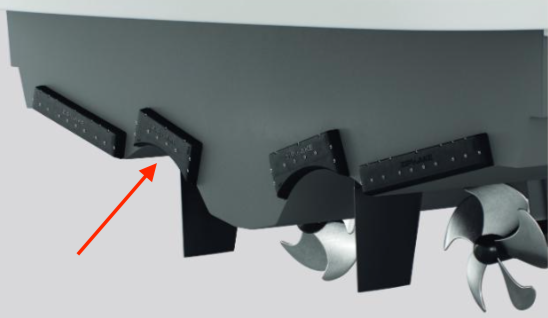
Refined Control
Comparatively speaking, interceptors travel small distances and can be adjusted in finer increments. A Zipwake unit has a stroke distance of 1.18” (30 mm) and can be adjusted .02” (.5 mm) at a time. There’s a gauge in the control panel that lets a captain monitor each adjustment. Generally speaking, trim tabs don’t offer as much precision.
Focused Application
Because of the smaller blade area, interceptors need a stronger waterflow to be effective. This means that they are not intended for use on slower boats. For example, a heavy trawler that cruises at 8 to 10 mph doesn’t create enough flow over the blades for interceptors to create lift. In this application, trim tabs would be more effective.
At the other end of the spectrum, most interceptor blades can be damaged at speeds exceeding 60 knots because the force on the blade would be too much. Because tabs deploy at a shallower angle, they can still be used at higher speeds.
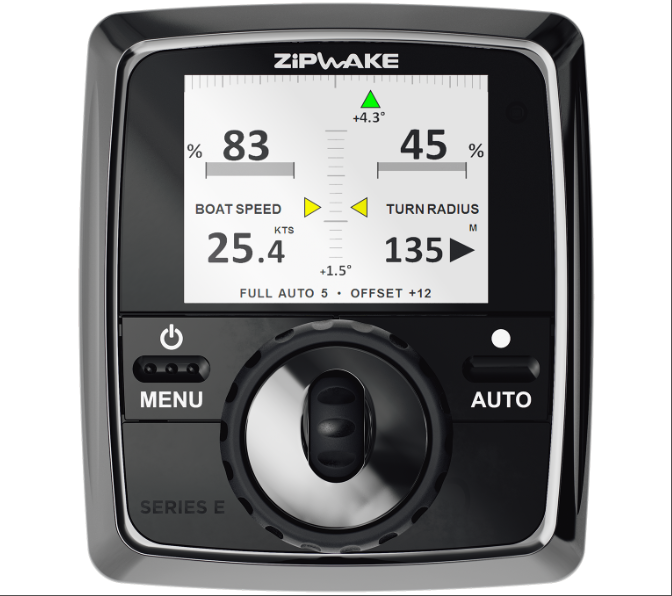
Zipwake S Series
The S Series of Zipwake interceptors is for boats measuring 20’ to 50’ (6.1 m to 15.24 m). They have a concealed cable mounted above the waterline, which helps reduce corrosion and the control panel can be positioned at any angle between 0 and 360 degrees in a gimbal bracket or it can be flush mounted. The Smart Ride Controller uses 12V DC power and has an IP67/IP64 waterproof rating on the front and back respectively. The S Series is fully automatic and includes four straight, four V-shaped, two chine and one intermediate interceptors in a range of sizes.
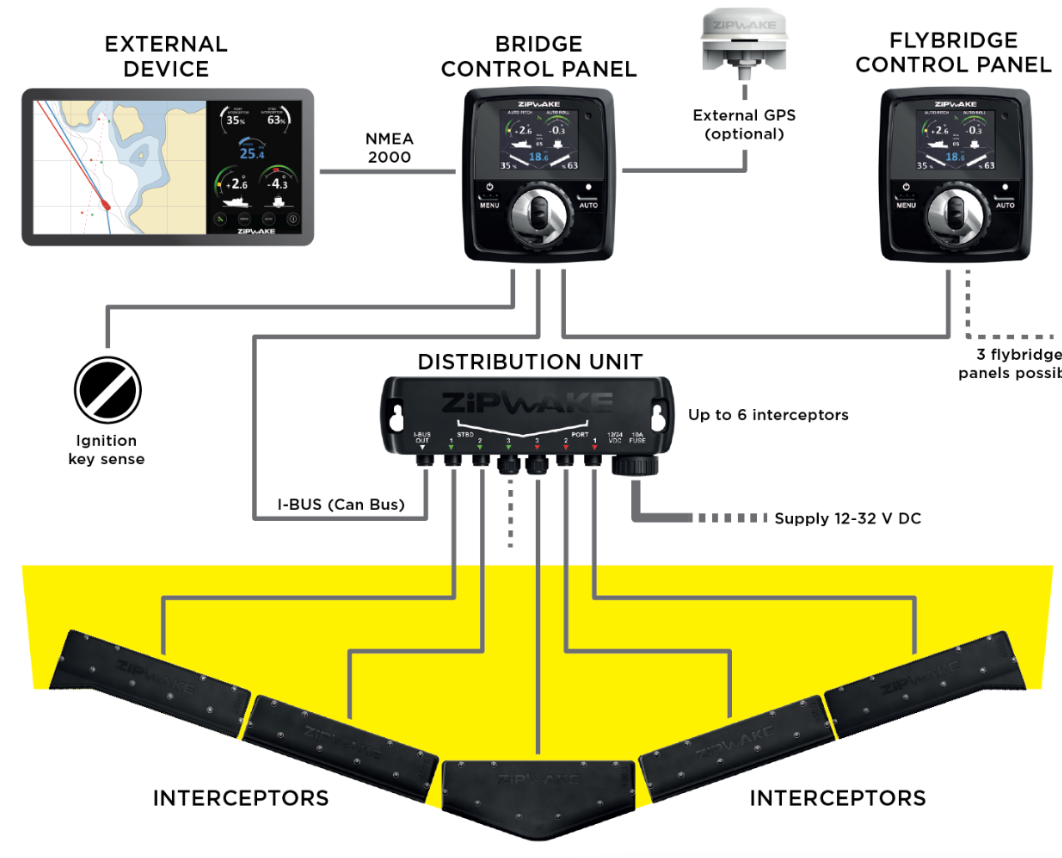
Zipwake E Series
The E Series is a large series of interceptors that includes three straight, three tunnel units and two chine models. The Dynamic Trim Control System Series E is an evolved version of the S Series that incorporates larger interceptors designed for boats measuring 50’ to 100’ (15.24 m to 30.48 m). The E Series uses 3D controls with a large display to provide the captain with user-friendly, intuitive management of running trim and heading. The fully automatic system can enhance performance, fuel economy, comfort and safety.
E Series highlights include a mass-produced modular design for simpler installation and easier expansion. The system can be monitored and controlled from external devices such as multifunction displays or chartplotters via an NMEA 2000 interface. It’s upgradeable via a USB stick and up to four control panels can be used on a boat with flush or gimbal-bracket mountings. Additionally, the Zipwake units are self-cleaning, which helps prevent interior fouling.
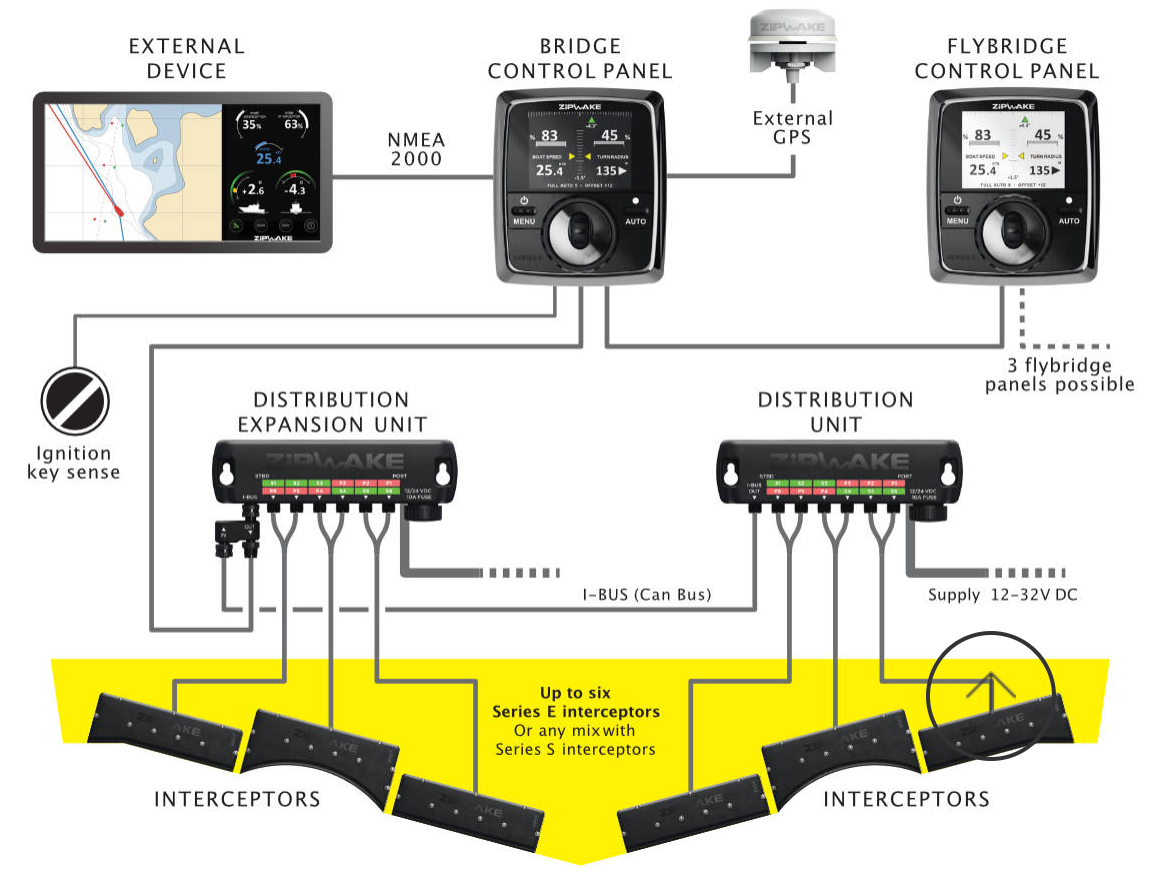
Pricing
Pricing for Zipwake units is similar to that for conventional trim tabs. Both require mounting the unit to the boat’s transom and adding a control at one or more helm stations and linking them via supplied cabling. A pair of 12” x 9” (30.48 cm x 22.69 cm) Bennett BOLT electric trim tabs has a retail price of $545 and adding auto trim bumps the price of the equipment to $1,195. The Zipwake 300S kit retails for $2,730 and includes everything needed to install the equipment. It should be noted that Zipwake systems include a built-in GPS, 3D-gyroscope and a 3D-accelerometer